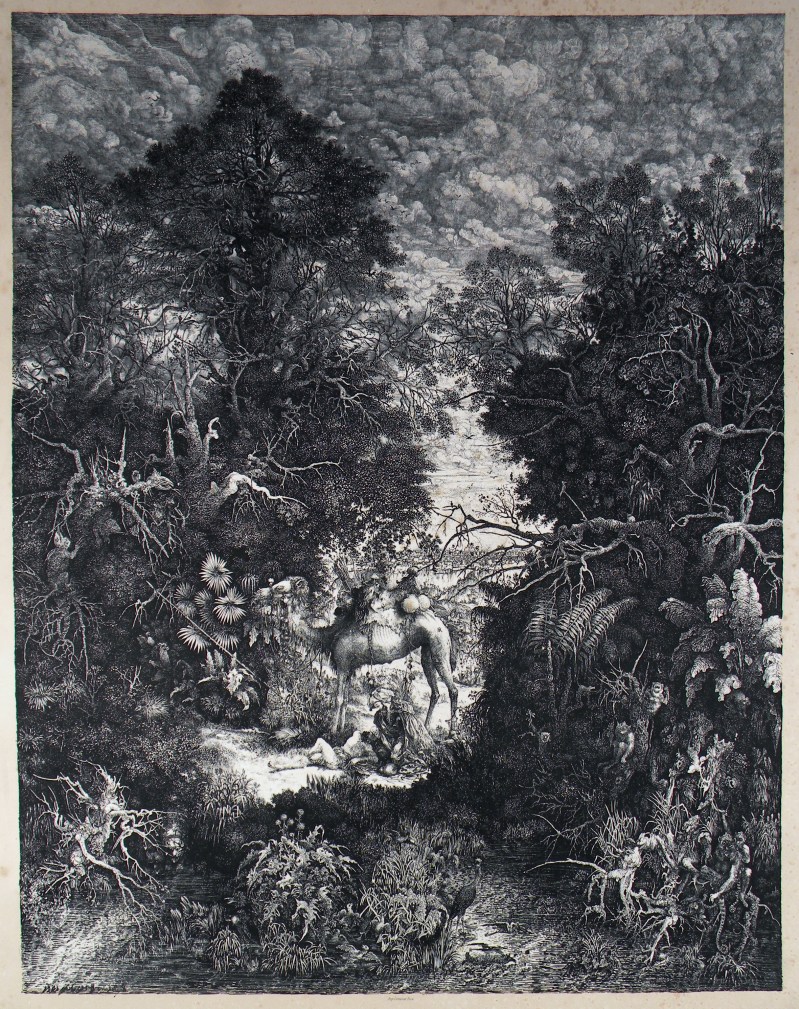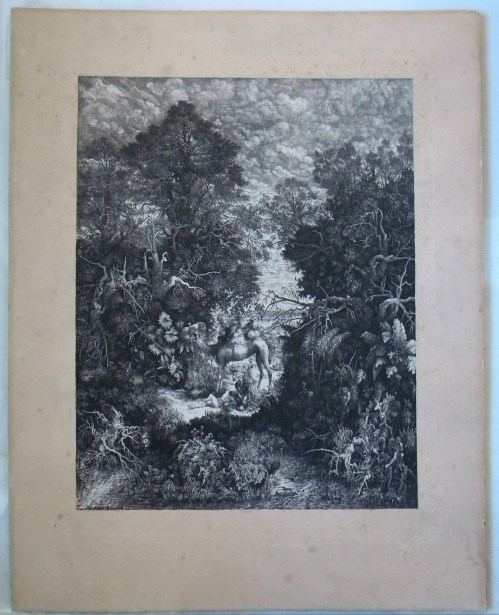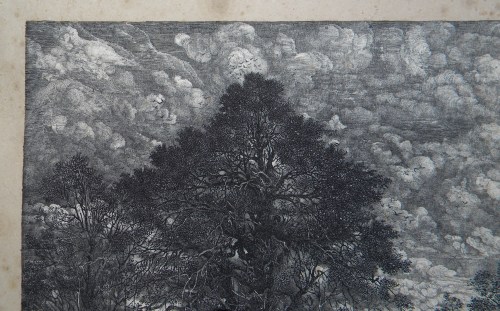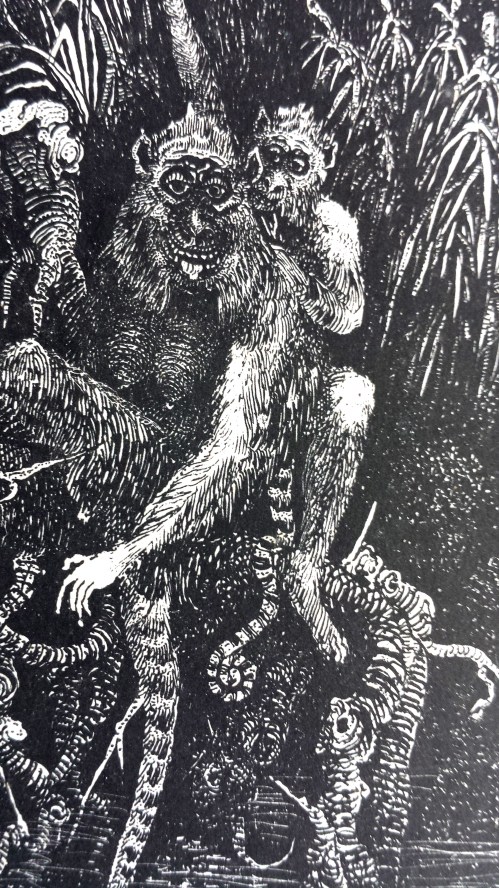Rodolphe BRESDIN: Le Bon Samaritain - 1861
SOLD
[The Good Samaritan]
Lithography, 565 x 445 mm. Van Gelder 100, 1st edition, 1861; Becker 1st state (of 2); Préaud 29, 1st state before 1A and 1B.
Very rare impression of the first state before any deterioration of the lithographic stone: before the black smudge on the left leg of the monkey, before the “white bird” and before the white thistles.
Splendid impression printed on white chine appliqué on cream wove paper. The chine appliqué paper is slightly smaller than the image, whose edges, especially the bottom one, are printed on the sheet of wove paper.
The print is in very good condition. Some minor defects: a few foxmarks, two very small hollows without tear, two minor surface scratches. Some foxing in the margins and small tears at the edges of the sheet. Exceptionally wide margins: 870 x 620 mm. The left and right edges of the sheet are attached to a mount board; the upper and lower margins are folded and attached verso over an area of 20 to 30 mm. A label is pasted on the back of the board: RUE ST ANTOINE DU T N° 21 / VITAUX /ENCADREUR.
In March 1861, Bresdin, who had been living in Toulouse for almost ten years, went to Paris with a large lithographic stone whose subject was the good Samaritan. In Paris, he had the lithograph printed for the first time between mid-March and mid-April by Lemercier. On April 9, Bresdin wrote to his friend Justin Capin, who was living near Toulouse, to tell him that the printing of his stone had been successful and that his lithograph was well-received. He asked Capin to help him sell a dozen or so impressions to his acquaintances and said he was about to send some impressions to Toulouse and “everywhere”. On May 1, his lithograph was exhibited in the Paris Salon, with the title: Abd el-Kader secourant un chrétien. On May 6, the lithograph was also exhibited in the Exposition des Beaux-Arts organized in Toulouse by the Union Artistique, of which Bresdin's close friend, the painter Jules Garipuy, who was a teacher at the École des Beaux-Arts and a curator at the Musée des Augustins, was one of the founders. Bresdin's lithograph was listed in the exhibition catalog in the part dedicated to the Prints, lithographs and photographs: “BRESDIN (Rodolphe) à Paris. 6 : Le Samaritain (lithographie).” (p. 75).
We don’t know how many impressions of Le Bon Samaritain were printed by Lemercier in 1861. According to Van Gelder, this first edition seems to have been “relatively limited”. Later issues were made in 1867, 1871, 1873, 1880, 1882 and some impressions might have been printed again in 1899, after Bresdin's death, for his daughter Rodolphine. The lithograph was also transferred onto another stone in 1868.
The dating of the impressions of Le Bon Samaritain is based upon the quality of printing and upon the chronology of the defects due to the alterations of the stone, whose earliest, as D. P. Becker pointed out, is the black smudge on the left leg of the monkey; then come the “white bird” stain in the lower left corner and the white thistles to the left of the camel (Becker, 1983, pp. 10-11). The impressions from the “pierre de report”, which are titled Le Bon Samaritain in the bottom margin, show these same defects.
Our impression is one of the very few copies which show none of the defects due to the alteration of the lithographic stone. Considering its very high quality, we may regard it as one of the earliest impressions, among which some were printed on white chine (Becker, 1983, p. 11, 14). The label of the frame-maker Vitaux pasted on the back of the mount board may be also a clue that it is one of those sent by Bresdin to Toulouse in April 1861 before the opening of the Beaux-Arts Exhibition. Louis Joseph Vitaux, a frame-maker and print dealer, was also a member of the Union Artistique (his name, spelled Viteaux, is listed as a founding member in the exhibition catalog (page 23) and in the April 12, 1861 issue of the Journal de Toulouse with the mention “frame-maker”). In his letter to Justin Capin dated 9 April, Bresdin himself suggested having the lithographs framed to sell them more easily: “As the proofs are quite large, I would rather have them framed and send them to you 'ready to sell': the buyers would save some money and be more satisfied” (Van Gelder, 1976, our translation). We may suppose that Bresdin gave up the idea of having the lithographs framed in Paris (the shipping costs would have been too high), and suggested having them framed in Toulouse instead, before or after the Beaux-Arts Exhibition.
References: Dirk van Gelder, Rodolphe Bresdin , La Haye, 1976: vol I. Appendice IX, Lettre à Justin Capin du 9 avril 1861, p. 196; vol. II: Catalogue raisonné de l’œuvre gravé, no. 100, pp. 66-73; Maxime Préaud (et alii), Rodolphe Bresdin, 1822-1855, Robinson graveur, Paris, Bibliothèque nationale de France, 2000, pp. 65-81; David P. Becker, "Rodolphe Bresdin's Le Bon Samaritain", in Nouvelles de l'estampe, no. 70-71, juillet-octobre 1983, pp. 7-14; Union Artistique, Toulouse, 1861, Catalogue of the Exposition des Beaux-Arts ouverte à Toulouse le 6 mai 1861, p. 75 (online pdf file on the website of the Toulouse Library); Journal de Toulouse, no. 101, April 12, 1861.
Price on application






